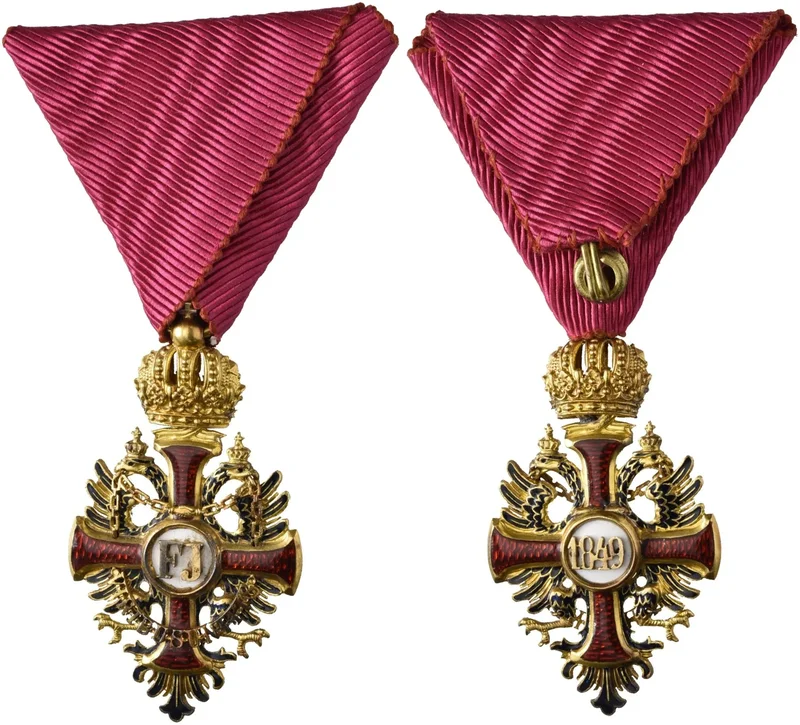World Orders and Decorations (Germany, Europe, Overseas, Lots 4501-4599)
Bid
| Starting price | 500 CHF |
| Result |
This lot is not available for purchase anymore.
Imperial Austrian Order of Franz Joseph. 2nd-model (about 1860 until 1918), 1st-edition (in gold - until 1916), Knight’s cross, manufacturing of Vincent Mayer’s Söhne in Vienna between 1866 and 1916, edition with „unfilled“ imperial crown, 750/000 gold and enamels, on the ring manufacturer’s indicaction and Vienna hallmark from 1866 until 1922 (3 chamois A), reverse centre can be opened, with original old triangular ribbon. BWK1 668.
Kaiserlich Österreichischer Franz Joseph-Orden. 2. Modell (ca. 1860 bis 1918), 1. Ausgabe (in Gold - bis 1916), Ritterkreuz, Anfertigung der Firma Vincent Mayer’s Söhne in Wien zwischen 1866 und 1916, Ausführung mit nicht emaillierter Kaiserkrone, 750/000 Gold emailliert, auf dem Ring Herstellerbezeichnung und Wiener Goldpunze zwischen 1866 und 1922 (3 Gamskopf A), das Revers-Medaillon kann geöffnet werden, am originalen alten Dreiecksband. BWK1 668.
Fast vorzüglich / About extremely fine.
(~€ 465/USD 550)
• Dieses Los unterliegt bei Auslieferung in der Schweiz der Margenbesteuerung gemäss MWSTG 24a (22.5% Aufgeld inkl. Gesetzlicher Mehrwertsteuer)
• When delivered in Switzerland, this lot is subject to the margin taxation scheme in accordance with article 24a of the Federal Act on Value Added Tax (22.5% buyer’s premium incl. Statutory VAT).
The originally three-class (Grand Cross, Commander and Knight) order for civil and military merit was established on December 2, 1849, by Emperor Franz Joseph I (1830-1916, reigned since 1848) on occasion of the one-year jubilee of his accession to the throne. With statute amendment of December 25, 1850, the class of Commander was divided into Commander with Star [Komtur mit Stern] and Commander [Komtur]. By February 1, 1901, the class of Officer [Offizier] was created, situated between Commander and Knight, so that the order now - as only Austrian order - had five classes. With special decree dated September 14 and December 31, 1914, for the Knights and Commanders, the war ribbon (of the cross for military merit) was introduced for war merit. For the Officer’’s cross, this was introduced in form of a rosette behind the cross on January 10, 1915, and for the Grand Cross only on August 1, 1917. Already on August 13, 1916, the war decorations for the breast stars were introduced, and so were, on December 13, 1916, the swords for all classes. With the renouncement of Emperor and King Karl I (1887-1922, reigned from 1916 until 1918 as Emperor Karl I of Austria, as King Károly IV of Hungary and Croatia and as King Karel III of Bohemia) from state affairs on November 11, 1918, for Austria and on November 13, 1918, for Hungary, the conferring of the Imperial awards ended. With the proclamation of the Republic of Austria on November 12, 1918, the monarchy and all its symbols, among which also the orders of chivalry and decorations, were de facto abolished. This was confirmed by law of April 3, 1919 [„Gesetz vom 3. April 1919 über die Aufhebung des Adels, der weltlichen Ritter- und Damenorden und gewisser Titel und Würden“], which in its § 5 declares „that the orders of chivalry and the ladies’ orders . . . are abolished“. This law, with some amendments, is still in force until present.
Details
When delivered in Switzerland, this lot is subject to the margin taxation scheme in accordance with article 24a of the Federal Act on Value Added Tax (22.5% buyer’s premium incl. statutory VAT)
